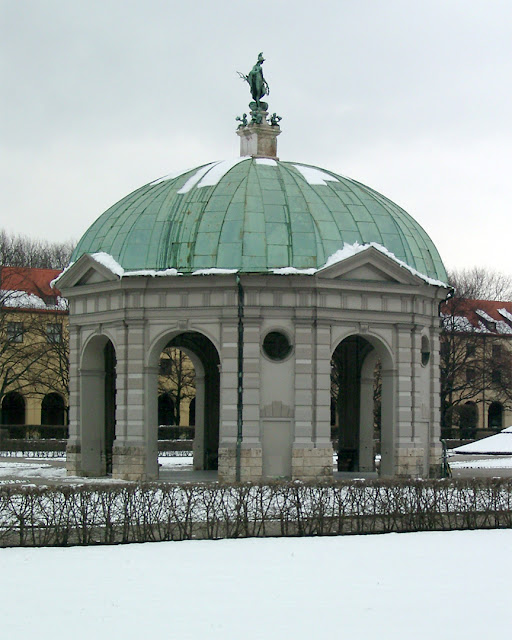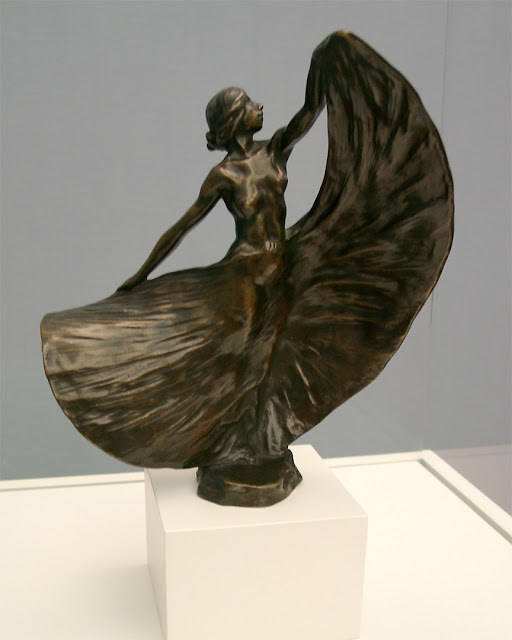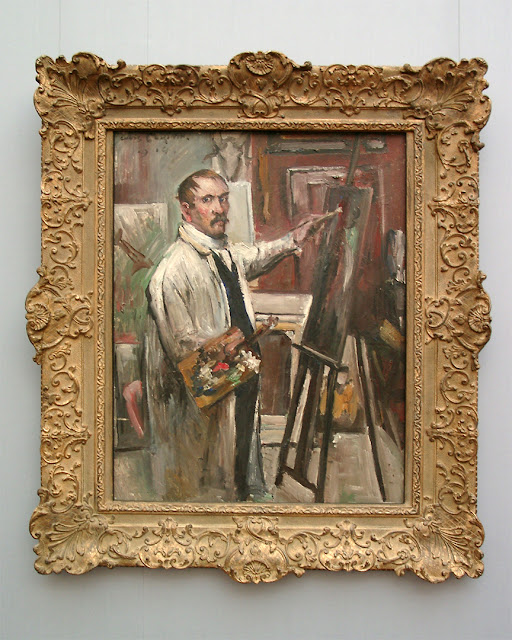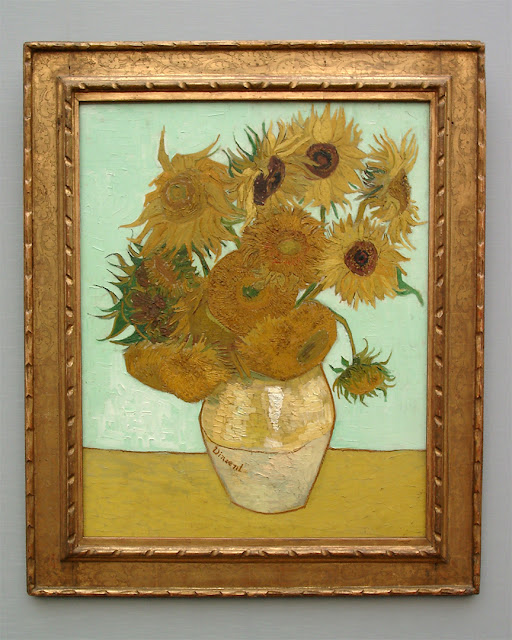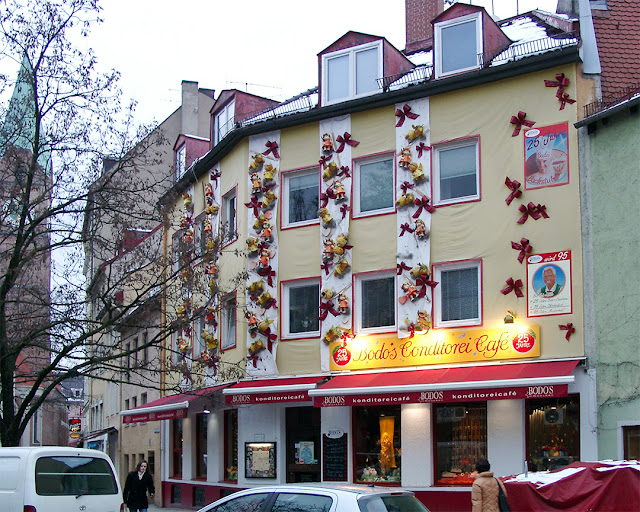Sunday, August 31, 2008
Saturday, August 30, 2008
Friday, August 29, 2008
Thursday, August 28, 2008
Wednesday, August 27, 2008
Tuesday, August 26, 2008
Monday, August 25, 2008
Fischbrunnen
Fischbrunnen (Fish Fountain) by Konrad Knoll
Marienplatz
Munich, March 2004
“The Fischbrunnen is a fountain in the center of Munich, whose history can be traced back to the Middle Ages. In 1954, Josef Henselmann created the fountain in its present form, using parts of Konrad Knoll’s neo-gothic fountain that was destroyed during the Second World War.” (Fischbrunnen, Wikipedia)
Sunday, August 24, 2008
Saturday, August 23, 2008
Friday, August 22, 2008
Thursday, August 21, 2008
Beyond the Isar
Maximilianeum
Max-Planck-Straße
Munich, March 2004
“The Maximilianeum, a palatial building in Munich, was built as the home of a gifted students' foundation but since 1949 has housed the Bavarian State Parliament. It sits grandly and as a focal point on the bank of the Isar River above Maximilian Bridge at the eastern end of Maximilianstrasse, a royal avenue dotted with Neo-Gothic palaces influenced by the English Perpendicular style. Construction was the initiative of King Maximilian II of Bavaria in 1857, with Friedrich Bürklein the lead architect. Weight problems delayed completion until 1874, and the façade, which had been conceived as Neo-Gothic, needed to be altered; Gottfried Semper was entrusted with the adjustments, resulting in the final quasi-Renaissance appearance decorated with arches, columns, mosaics, and niches filled with busts. The much less visible rear of the edifice has been extended in motley fashion to provide new parliamentary office space, in 1958, 1964, 1992, and again in 2012, each time with a different architectural approach.” (Maximilianeum, Wikipedia)
Wednesday, August 20, 2008
Tuesday, August 19, 2008
Bayerisches Staatsministerium
Bayerisches Staatsministerium für Wirtschaft, Landesentwicklung und Energie
(Bavarian Ministry of Economic Affairs, Energy and Technology)
Prinzregentenstraße
Munich, March 2004
Monday, August 18, 2008
Bayerisches Nationalmuseum
Bayerisches Nationalmuseum (Bavarian National Museum)
Prinzregentenstraße
Munich, March 2004
“The Bavarian National Museum (German: Bayerisches Nationalmuseum) in Munich is one of the most important museums of decorative arts in Europe and one of the largest art museums in Germany.[citation needed] Since the beginning the collection has been divided into two main groups: the art historical collection and the folklore collection. The museum was founded by King Maximilian II of Bavaria in 1855. It houses a large collection of European artifacts from the late antiquity until the early 20th century with particular strengths in the medieval through early modern periods. The building, erected in the style of historicism by Gabriel von Seidl 1894-1900, is one of the most original and significant museum buildings of its time. It is situated in the Prinzregentenstraße, one of the city's four royal avenues. The house replaced an older building which houses today the Museum Five Continents. Already in 1905/06, the museum was expanded to the north by a few rooms and a workshop wing. German Bestelmeyer added a wing at the southeast corner in 1937.” (Bavarian National Museum, Wikipedia)
Sunday, August 17, 2008
Bayerische Staatskanzlei
Bayerische Staatskanzlei (Bavarian State Chancellery)
Franz-Josef-Strauß-Ring
Munich, March 2004
“Bayerische Staatskanzlei (Bavarian State Chancellery) is the name of a state agency of the German Free State of Bavaria and also of the appendant building. Bayerische Staatskanzlei is also the name of the building in Munich that houses the personal offices of the chancellery staff. It was erected from 1989 to 1993 around the central dome of the former Bavarian Army Museum, which had been built in 1905 at the site of the Hofgartenkaserne barracks and was demolished in World War II. The museum then was moved to the New Castle in Ingolstadt.” (Bayerische Staatskanzlei, Wikipedia)
Saturday, August 16, 2008
Dianatempel
Dianatempel (pavilion for the goddess Diana)
Hofgarten
Munich, March 2004
“The Diana Temple in the Munich Hofgarten, the garden of the Munich Residenz, is a twelve-sided gazebo from the Renaissance period with eight open and four closed round arcades. It is the crossing point of the main and diagonal axes of the Hofgarten. The Diana Temple was created in 1613–1617 in Italian style together with the Hofgarten and goes back to Maximilian I, Elector of Bavaria. The temple forms the center of the garden and was probably created by Heinrich Schön around the year 1615. On it is a famous bronze figure, a copy of the Bavaria bronze statue of Hubert Gerhard. The original can be found in the Residenzmuseum. The bronze figure that crowns the roof was created in 1594 by Hans Krumpper and symbolizes the riches of Bavaria. In the temple itself, four wall mounted shell fountains can be found.” (Dianatempel, Wikipedia)
Friday, August 15, 2008
Theatine Church
Theatinerkirche (Theatine Church)
Salvatorplatz
Munich, March 2004
“The Theatine Church of St. Cajetan and Adelaide (German: Theatinerkirche St. Kajetan und Adelheid) is a Catholic church in Munich, southern Germany. Built from 1663 to 1690, it was founded by Elector Ferdinand Maria and his wife, Henriette Adelaide of Savoy, as a gesture of thanks for the birth of the long-awaited heir to the Bavarian crown, Prince Max Emanuel, in 1662. Now administered by the Dominican Friars, it is also known as the Dominican Priory of St. Cajetan. The church was built in Italian high-Baroque style, inspired by Sant'Andrea della Valle in Rome, designed by the Italian architect Agostino Barelli. His successor, Enrico Zuccalli, added two 66 meters high towers, originally not planned, and then finished the 71-metre-high (233 ft) dome in 1690. The church is 72 metres (236 ft) long and 15.5 metres (51 ft) wide. The facade in Rococo style was completed only in 1768 by François de Cuvilliés. Its Mediterranean appearance and yellow coloring became a well known symbol for the city and had much influence on Southern German Baroque architecture.” (Theatine Church, Wikipedia)
Thursday, August 14, 2008
Wednesday, August 13, 2008
Die Tänzerin Loïe Fuller
“Die Tänzerin Loïe Fuller” (The Dancer Loie Fuller) by François-Rupert Carabin, 1897
Neue Pinakothek
Barer Straße
Munich, March 2004
“Loie Fuller (born Marie Louise Fuller; January 15, 1862 – January 1, 1928), also known as Louie Fuller and Loïe Fuller, was an American actress and dancer who was a pioneer of both modern dance and theatrical lighting techniques.” (Loie Fuller, Wikipedia)
Tuesday, August 12, 2008
Lovis Corinth
Selbstbildnis (Self-Portrait) by Lovis Corinth, 1914
Neue Pinakothek
Barer Straße
Munich, March 2004
“Lovis Corinth (21 July 1858 – 17 July 1925) was a German artist and writer whose mature work as a painter and printmaker realized a synthesis of impressionism and expressionism. Corinth studied in Paris and Munich, joined the Berlin Secession group, later succeeding Max Liebermann as the group's president. His early work was naturalistic in approach. Corinth was initially antagonistic towards the expressionist movement, but after a stroke in 1911 his style loosened and took on many expressionistic qualities. His use of color became more vibrant, and he created portraits and landscapes of extraordinary vitality and power. Corinth's subject matter also included nudes and biblical scenes.” (Lovis Corinth, Wikipedia)
Monday, August 11, 2008
Sonnenblumen
“Sonnenblumen” (Sunflowers) by Vincent van Gogh, 1888
Neue Pinakothek
Barer Straße
Munich, March 2004
“Vase With Twelve Sunflowers was painted as decoration for the Yellow House, the apartment Van Gogh rented and hoped to turn into an artist studio. A place he could invite fellow artists and they could work side by side as they developed their craft. There are two versions of this enigmatic painting, still to this day considered one of the most remarkable still life paintings ever completed. Van Gogh made a second version, or a ‘repetition’ as he called it, as he was afraid he might lose the original, either through postal damage, or Paul Gauguin, the artist whom stayed with him and expressed so much admiration for it, may take it for himself. There are slight differences between the two versions, the other is part of the permanent collection at The Philadelphia Museum of Art.” (Vincent Van Gogh Paintings at Neue Pinakothek, Van Gogh Studio)
Sunday, August 10, 2008
Ratapoil
“Ratapoil” by Honoré Daumier, 1850
Neue Pinakothek
Barer Straße
Munich, March 2004
“The nickname Ratapoil (Skinned Rat) appeared on 12 August, again in Le Charivari. In 1875, it was featured in the Grand Dictionnaire Universel du XIXe siècle where it was defined as a familiar term for a supporter of militarism, and particularly of Napoleonic imperialism. Daumier probably modelled his statuette in March 1851. The volumes are exaggerated, unbalanced, fragile and powerful at the same time, endowing the work with a subversive violence commensurate with the political issue. Along with the exaggeratedly curved posture, the crumpled trousers and frock coat, as a final flourish, he adds a fiendish expression to the face. Although Ratapoil's features do not directly caricature those of the Prince-President, the Imperial whiskers remain an immediately recognisable symbol of the enemy.” (Ratapoil, Google Arts & Culture)
Saturday, August 9, 2008
Der arme Poet
Der arme Poet (The Poor Poet) by Carl Spitzweg, 1837
Neue Pinakothek
Barer Straße
Munich, March 2004
“The Poor Poet (Der arme Poet) is the best known and most popular painting by German painter Carl Spitzweg. It was executed in 1839 and had three versions. The painting depicts a poet in his poor attic room. The narrow room is illuminated by a small window on the left. On the right there are the rafters of the house roof, on which an umbrella hangs, to protect the sleeping area from the moisture dripping through the roof. The room door can be seen on the right edge of the painting. Opposite the door, on the left edge of the picture, there is a green tiled stove without fire. The poor poet has no bed: instead he lies in a mattress against the wall of the floor, in a dressing gown, with a sleeping hat on his head. On his knees he holds some pages of a manuscript with his left hand. With the fingers of his right hand he appears to be counting the meter of a poem. In front of the mattress, there are thick books and two boxes with an inkwell on them. On the spine of the upright book on the far right are the Latin words: Gradus ad Parnassum (German: Klassen zum Parnass), which is either the title of the main theoretical work published by the Austrian composer Johann Joseph Fux or, most likely, the instructions for writing Latin verses published by the Jesuit priest Paul Aler in Cologne in 1702. On the wall, the poet probably painted the meter of the hexameter in red. There is a candle in the bottle on the green tiled stove, next to it the wash bowl, and a towel hangs on a clothesline above it. A top hat hangs on the unheated stovepipe. There are sheets of paper in the furnace hole, which probably belong to the papers that lie in front of it, and which, also in Latin, are labeled Operum meorum fasciculum III The third bundle of my works). There is also a single boot and a boot jack in front of the stove. To the left of the stove is a pot, the dressing gown is hanging on the wall next to it and the walking stick is leaning against the wall on the far left of the picture. Snow-covered roofs are seen behind the window, in an indication that it's cold. However, the poet is so poor that he remains in bed to keep himself warm. He can only heat himself if he burns his works.” (The Poor Poet, Wikipedia)
Friday, August 8, 2008
Gotischer Dom am Wasser
Gotischer Dom am Wasser (Gothic Cathedral by a River) by Karl Eduard Biermann, 1830
Neue Pinakothek
Barer Straße
Munich, March 2004
“Gothic Cathedral by a River (Gotischer Dom am Wasser) is an 1813 painting by German artist and architect Karl Friedrich Schinkel. It shows an imaginary Gothic cathedral on an island in a river - Schinkel later became a noted proponent of Neo-Gothic architecture. It is held in the Alte Nationalgalerie, in Berlin. Painted in the late afternoon, the sun setting behind the cathedral shines through the intricate tracery of the towers, illuminating their fine detail, such as the spiral staircase and the connecting bridge. The painting is notable by virtue of the number of replica and derivative works produced, the authorship of which are a matter of debate. On Schinkels's death in 1841 three replica versions existed, one of which was lost in the Munich Glaspalast fire in 1931, another of which is in St Petersburg and the third of which is in the Berlin Altegalerie (see right). Variant works based on Shinkel's original can be found in the Neue Pinakothek, in Munich (by Karl Eduard Biermann), and in private hands (by Johann Theodor Goldstein, 1822).” (Gothic Cathedral by a River, Wikipedia)
Thursday, August 7, 2008
Wednesday, August 6, 2008
Tuesday, August 5, 2008
Monday, August 4, 2008
Staatliche Antikensammlungen
Staatliche Antikensammlungen (State Collections of Antiquies)
Königsplatz, Kunstareal
Munich, March 2004
Sunday, August 3, 2008
Saturday, August 2, 2008
Friday, August 1, 2008
Subscribe to:
Posts (Atom)
















